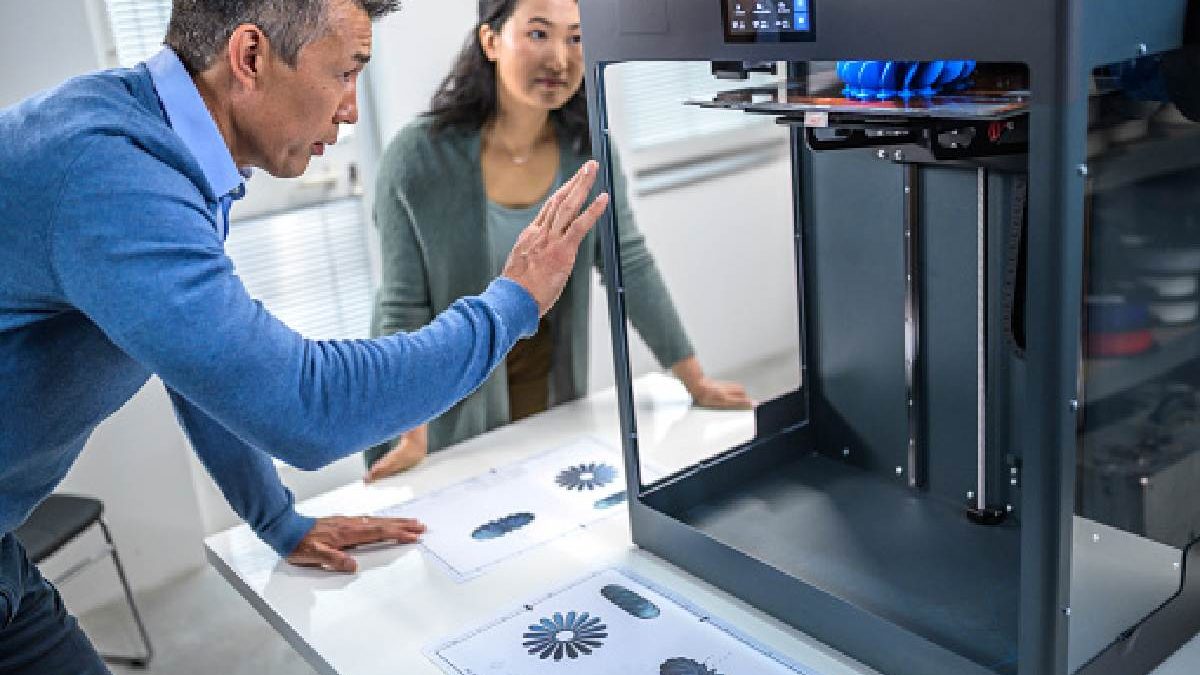3D Printers use computer-aided design (CAD) to create 3D objects from materials such as molten plastic, metals, or powders.
A typical 3D printer is much like a computer-driven inkjet printer. It builds a 3D model layer by layer, bottom to top, by printing repeats over a similar area in a method known as fused deposition modeling (FDM).
Working automatically, the printer creates a model over several hours by converting a 3D CAD drawing over many two-dimensional cross-sectional layers, i.e., separate 2D prints placed on each other, but without the paper, in between.
Instead of using ink, which would never reach high volume, the printer lays down layers of molten plastic or powder and fuses them (and to the existing structure) with adhesive or ultraviolet light.
Table of Contents
Why are 3D Printers Important for the Future?
As explained before, 3D printers are pretty flexible, not only in their materials but also in what they can print.
In addition, they are highly accurate and fast, making them a tool with great potential for future manufacturing. Today, many 3D printers are used for what is called rapid prototyping.
Companies worldwide are using 3D printers to create prototypes in a matter of hours instead of wasting months of time and money on research and development.
Some companies claim that 3D printers make the prototyping process ten times faster and five times cheaper than normal R&D processes.
In short, 3D printers can play a role in almost all sectors. They are not only being used for prototyping but are now being commissioned to print finished products.
The construction industry is using this futuristic printing method to print entire houses. Schools worldwide use 3D printers to bring hands-on learning into the classroom by printing dinosaur bones and robotics parts in three dimensions.
What was the First 3d Impression? (Brief History)
Science literature author Arthur C. Clarke was the first to describe the essential functions of a 3D printer, which became popular in 1964.
The first 3D printer was out in 1987 by Chuck Hull of 3D Organizations and used the “stereolithography” (SLA) process.
Other 3D printing technologies were released in the 1990s and 2000s, such as Stratasys’ FDM and 3D Systems’ SLS. These printers were expensive and used primarily for industrial prototyping.
How 3D Printing Works?
3D printing is a different way of producing parts than traditional subtractive manufacturing (CNC machining) or injection molding manufacturing technologies.
This technology does not require special tools (for example, a cutting tool with specific geometry or a growth). Instead, the part is manufactured straight on the platform built layer by layer, which comes with a unique set of trade-offs.
The process always twitches with a 3D digital model as the blueprint for the physical object. The printer software then slices this model into thin two-dimensional layers and converts it into a set of machine language instructions (G code) for the printer to execute.
From here, the operation of a 3D printer differs depending on the process. For example, desktop FDM printers melt plastic strings and deposit them onto the build platform through a nozzle (like a computer-controlled, high-precision glue gun).
Extensive industrial SLS machines routine a laser to melt (or sinter) tinny layers of metal or malleable powders.
Available materials also vary by process. Plastics are the most common, but metals can also be 3D printed.
The parts formed can also have a wide range of physical properties, ranging from optically transparent objects to rubber-like items.
Depending on the size of the part and the kind of printer, a print typically takes between 4 and 18 hours to complete.
3D Printing Steps
In the previous point, I quickly explained how additive manufacturing works. But how do you start from an idea and print it? I present it to you in the simplest way, using the steps to follow in a generic way to print an object in 3D.
- Step – Content Creation
- Step – Convert it to STL Format
- Step – Slicing
- Step – The Impression
- Step – Removing the Printer Parts
- Step – Post-Processing
3D Printing Materials
3D printing materials are closely related to 3D printing processes. At this point, we will focus on today’s most popular or common materials used in 3D printing and their most critical applications.
Each 3D printing process is well-suited to different materials. Plastics (thermoplastics and thermosets) are the most common, followed by metals and powders. Some composite and ceramic materials can also be 3D printed.
- Plastics
- Metals
- Powder
Examples of 3D Printing in Today’s World
3D printers are getting cheaper, and many experts don’t expect them to be long before they become commonplace in homes worldwide. Manufacturing companies also note the powerful capabilities these machines provide to businesses and their production processes.
Every day, a breakthrough is being made that pushes the boundaries of 3D printing. From medical devices to aircraft parts to shoes, 3D printing can create just about anything you can imagine. It’s just a matter of scale. Below are some examples and real applications of 3D printing that can be seen today.
- Manufacturing industry
- Education and Training
- Industrial Robotics
- Houses and buildings
- Prosthetic limbs and body parts
- Musical instruments
- Food
Related posts
Featured Posts
Networking – Brief Explanation
What is Networking? In the professional and business world, networking is the practice of making contacts, that is, meeting other…
Social Networks – Brief Explanation
What are Social Networks? Social networks are digital platforms formed by groups of individuals with common interests, activities, or relations…



